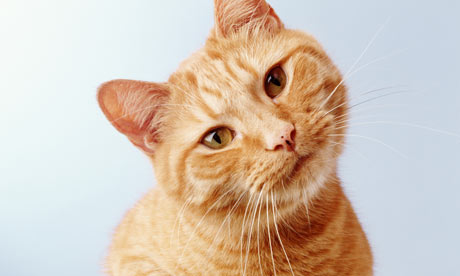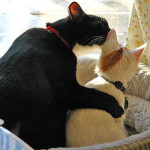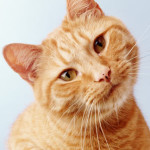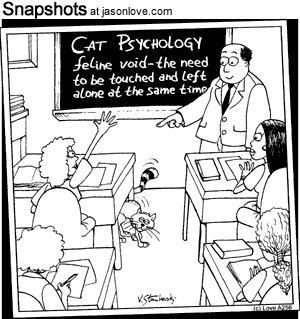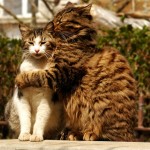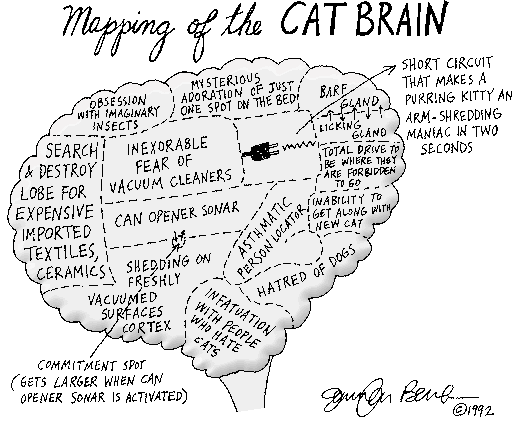In the days when my family had Benjie the golden retriever I was unequivocally a doggie person, something my sister never lost. Somewhere along the line I was converted to cats (as opposed to Catholicism.) The main reason was practicality, I guess – it’s difficult to live an itinerant working lifestyle and be there to take dogs for walks at regular intervals, though when we began to allow cats into our lives there were no catflaps in the house and my then wife would not have cat litter trays either, so the mog had to beg to go out, and was let out during the day to wander round at will, hide in outbuildings if it rained, beg at neighbours for additional meals and whatever else they get up to.
When I bought my current house with a ready-made cat flap, it was almost like I had no choice but to get cats at that point. After all, so long as they got fed they were free agents. I could lock the house and they could do what they want. Being cats, they had the usual range of expected behaviours (being fussy about cat litter, furballs, dragging in dead birds and suchlike), but by and large they can lounge around and sleep to their hearts’ content.
Of my two, one is the shop steward and the alpha female. Molly is a very vocal cat, forever moaning and whinging about one thing or another. She likes to pretend she is ‘hard’; if she were human you could imagine her with a permanently belligerent expression and wearing a studded black leather jacket. But even so she will come to me demanding kittenish attention when she thinks nobody else is watching. She is also the hunter of the two whenever the mood takes her, which thankfully is not that often – but finding ‘gifts’ of dead birds in varying stages of dismemberment around the house is, to say the least, disconcerting!
Misty on the other hand loves attention but is decidedly timid. It takes her a good while to gain courage to come and sit on your lap, and even then she will take flight if you move suddenly. I think at some point she was traumatised by a man, resulting in no little nervousness and difficulty trusting the male gender in particular. She is however sweet and gentle by nature, much loved by all visitors, often for her beautiful grey fluffy coat – which on one occasion she lost by virtue of her fur having matted up into dreadlocks. A naked body with furry head, tail and legs looked bizarre but endearing until it all grew back!
One aspect of behaviour the two share is their determination not to be captured and put in cat boxes for any reason, including visits to the cattery and the vet, both of which are just around the corner, literally. If this pair are convinced of anything, it is that they DO NOT want to go in the box for any reason, and if after a struggle they are encaged they mew pitifully and look pathetic.
Now if you want advice about cat psychology, there is much of it available on the net and in books. Indeed, there seems to be an industry built around defining the behaviour of cats. You can read about their body language or even how to train them (thought that was – well, like herding cats?) So for example, most moods are identifiable through body language (courtesy of Wikipedia):
Cats rely strongly on body language to communicate. A cat may rub against an object, lick a person, and purr to show affection. Through purring a cat can show extremes of any emotion, and may do so when hurt. For example, a cat in pain purrs to show humans it is ready to be helped. Kittens are able to purr shortly after they are born, and purr while nursing. A cat’s main use of body language is through its tail. Cats will flick their tails in a relaxed manner or abruptly from side to side to express those respective feelings. If spoken to, a cat will start fluttering its tail to acknowledge the interaction.
And also note the possessive and territorial behaviours such as scent rubbing and spraying:
This behavior is used primarily to claim ownership of something, each cat releases a different pheromone combination from scent glands found in the cheeks next to their mouths. Facial marking behavior is used to mark their territory as secure and can be seen as a cat feeling secure rubs on prominent objects in the home (when feeling secure). This facial marking pheromone has been synthesized and is available as commercial product (Feliway). They also have scent glands towards the base of the tail. Unlike intact male cats, female and neutered male cats usually do not spray. Neutered males may still spray after neutering, if neutered late. Female cats often spray while in heat, so males can find them. Spaying may cause female cats to spray through loss of female hormones, also making them act more like males, which is why some female cats start spraying after being spayed, but if they started spraying before being spayed, it is most likely caused by female hormones, and they may stop after getting spayed.
But cats specialise in defying logic and doing their own thing with an attitude both aloof and arrogant – unlike soppy dogs who will look eager and thrilled to see you. Cats have perfected the art of looking aloof, intelligent and disdainful as a means of disguising the fact that they are in fact total airheads. Pavlov’s dogs may have been easy to train and keen to earn rewards, but Pavlov’s cats would have been telling Pavlov where to get off – they truly can’t be arsed, being totally narcissistic critters. Where dogs treat you, leader of the pack and wear their hearts on their sleeve, with cats it’s always ME ME ME but in a subtle, more sophisticated way such that you are not always sure you are being manipulated.
As they learn with experience, cats don’t lose the curiosity of youth but do identify and adopt inherently devious forms of behaviour to get their own way. Common behaviours they might share, such as the tendency to engage in the breastfeeding routines they used on their nursing mothers as tiny kittens: kneading with the claws. As further explained on Wikipedia:
Kneading is an activity common to all domestic cats whereby, when in a state of ease, they alternately push out and pull in their front paws, often alternating between right and left limbs. Some cats actually appear to “nurse” or suck on clothing or bedding during kneading. As with most domestic animals but especially cats and dogs they retain juvenile characteristics and behavioral traits. Kneading is something a kitten does to the nursing mother cat to help massage the mammary glands to produce more milk. As they are weaned they no longer need to do this and tend to do it when very content. This releases pleasurable endorphins for the cat, as it was once an instinctive thing to do.
Then we have the body postures:
A cat’s posture communicates its emotions. It’s best to observe cats’ natural behavior when they’re by themselves, with humans, and with other animals. Their postures can be friendly or aggressive, depending upon the situation. Some of the most basic and familiar cat postures include the following:
- Relaxed posture – The cat is seen lying on the side or sitting. Its breathing is slow to normal, with legs bent, or hind legs laid out or extended when standing. The tail is loosely wrapped, extended, or held up. It also hangs down loosely when the cat is standing.
- Alert posture – The cat is lying on its belly, or it may be sitting. Its back is almost horizontal when standing and moving. Its breathing is normal, with its legs bent or extended (when standing). Its tail is curved back or straight upwards, and there may be twitching while the tail is positioned downwards.
- Tense posture – The cat is lying on its belly, with the back of its body lower than its upper body (slinking) when standing or moving back. Its legs, including the hind legs are bent, and its front legs are extended when standing. Its tail is close to the body, tensed or curled downwards; and there can be twitching when the cat is standing up.
- Anxious/Ovulating posture – The cat is lying on its belly. The back of the body is more visibly lower than the front part when the cat is standing or moving. Its breathing may be fast, and its legs are tucked under its body. The tail is close to the body and may be curled forward (or close to the body when standing), with the tip of the tail moving up and down (or side to side).
- Fearful posture – The cat is lying on its belly or crouching directly on top of its paws. Its entire body may be shaking and very near the ground when it’s standing up. Breathing is also fast, with its legs bent near the surface, and its tail curled and very close to its body when standing on all fours.
- Terrified posture – The cat is crouched directly on top of its paws, with visible shaking seen in some parts of the body. Its tail is close to the body, and it can be standing up, together with its hair at the back. The legs are very stiff or even bent to increase their size. Typically, cats avoid contact when they feel threatened, although they can resort to varying degrees of aggression when they feel cornered, or when escape is impossible.
And of course vocal calls:
- Purring – Purring is often a sign of contentment. Some cats purr when they are in extreme pain, or in labour, simply to try to calm themselves down. Purring therefore can be a sign of pleasure or pain; usually it is the former. Scientists have not yet been able to discover how purring works, but it is suspected that it is caused by minute vibrations in the voice box.
- Greeting – A particular sort of vocalization, such as a low meow or chirp or a bark, possibly with simultaneous purring.
- Distress – Mewing is a plea for help or attention often made by kittens. There are two basic types of this call, one more loud and frantic, the other more high-pitched. In older cats, it is more of a panicky repeated meow.
- Attention – Often simple meows and mews in both older cats and young kittens. A commanding meow is a command for attention, food, or to be let out.
- Protest – Whining meows.
- Frustration – A strong sigh or exhaled snort
- Happy – A meow that starts low then goes up and comes back down.
- Watching – Cats will often “chatter” or “chirrup” on seeing something of interest. This is sometimes attributed to mimicking birdsong to attract prey or draw others’ attention to it, but often birds are not present.
But woe betide you if you assume cats will fall neatly into predictable patterns of behaviour. They prize their individuality, and the chances are that no two cats will react in exactly the same way to a common stimulus, and in that regard they are arguably more human than dogs?
There is one aspect of cat psychology spoken of on occasions is that cats are like women, and in body language and enjoyment of reclining comfortably and being cuddled and caressed that may well be true. Maybe a lot of ladies have feline qualities, but the implication by men is that women by nature are also perverse and occasionally tricky. While some undoubtedly fit that stereotype, and boy have I met a few in my time, I’d have said the reverse is true – men are generally more devious and women more honest and straightforward. This may just turn out to be a contentious point for further discussion!

